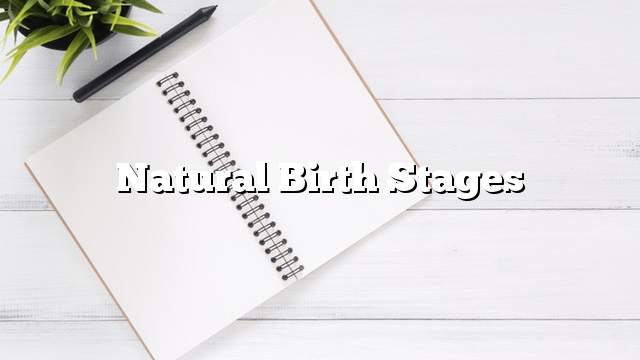Birth
The mother is looking forward to seeing her child, especially if she is her first child, and on the other hand is afraid of the experience of childbirth and the accompanying pain, But the experience of childbirth is easier than before, with a lot of centers that give lessons to the mother about birth, types, stages, and signs, and how to equip them.
Natural birth stages
Natural birth is divided into three stages:
- The stage of contractions of the uterus muscles, and in turn divided into three stages:
- Early stage: the longest stages of birth, sometimes extending from two to three days, and longer in the carrier for the first time (virgin), and the contractions are irregular, and rotate on the carrier every (5-20) minutes, ), And between mild to moderate intensity, and ends with the expansion of the cervix approximately centimeters, and the mother can do some things to feel comfortable at this stage, such as: exercise breathing exercises and relaxation, drinking enough water to maintain body moisture, Because the empty bladder facilitates the fetus’s descent, it can also be infused , Or practice some of the activities that occupy their time, such as reading, walking, listening to music, or even watching a movie.
- Active Stage: The contractions at this stage become more frequent and last for longer periods of 50-70 seconds, repeated every two or three minutes. This stage ends with the expansion of the cervix. The amniotic membrane may explode at the end. Stage Do the following to feel comfortable: walking around the room, lying on the bed on the left side, getting a massage, or wiggling on the birth ball, and getting a warm bath.
- The duration of this stage varies from one woman to another, usually lasting about one hour. However, it may last for three hours for the woman who is undergoing the birth experience for the first time. The contractions at this stage are longer and more close. Some women may find comfort if they get some massage, while some women may reject it. Cold or warm compresses can be used on the front or back as desired.
- The stage of the neonatal exit: This stage lasts between several minutes to several hours, and is shorter in the mother who experienced the birth experience before, continue the contractions at this stage between (60 – 90) seconds, repeated every (2-5) minutes, and ends This phase of the fetus out of the vagina.
- Stage of placenta: After the fetus exits, the uterine contractions continue to push the placenta out of the womb, and may continue beyond the placenta exit, which usually emerges within half an hour after the fetus’s exit. The contractions help to restore the uterus to its normal state and prevent the loss of much blood, To start breastfeeding immediately after birth, if possible, to assist in the secretion of oxytocin, which encourages the uterus to contract. If the stitches are needed, the doctor will decide.
Birth signs
Signs of approaching the birth date that the pregnant should pay attention to:
- Fetal descent into the pelvic area, putting pressure on the bladder, and increasing the desire to urinate, which may happen early a few weeks before birth, or just hours before birth.
- The mucus plug from the cervix to the vagina, which is mucous secretions that are pink or mixed with blood, may occur shortly after this sign, or after a week or two weeks.
- Contractions of the uterus muscles: These contractions move with a ripple from the top of the uterus to the bottom, causing pain in the back and lower abdomen, and different from the contractions of the false liar as regular, and does not stop when changing the pregnant status, or when moving, and contractions of the muscles of the uterus to shortness of the uterus and thinning Wall, and cervical expansion to up to (10) cm.
- Amniotic amniotic membrane rupture and fluid discharge, which is either net or straw-colored, and odorless.
The pregnant woman must also go to the hospital if:
- Disturbance occurs when contractions occur every five minutes for an hour.
- Rupture of the membrane.
- If fetal movement is less than normal.
- Vaginal bleeding.
Types of birth
The pregnant woman can choose the type of child that is comfortable and comfortable, there are many options that can be discussed by her doctor around, and choose the most appropriate for them, including:
- Vaginal delivery: Vaginal delivery, the choice most mothers tend to have; because the mother can then practice normal life quickly, and the risk of mother and child being infected is less.
- Water birth: Some women choose to be born in a large basin of warm water, because this type of birth reduces pain, and women feel relaxed, but be sure to clean the water in the basin to avoid infection.
- Caesarean section (C-section): It involves the incision of the abdomen and the uterus to remove the fetus. The advantage of this method is that the mother can choose the date of delivery in advance, but she needs to stay in the hospital for three days to obtain the necessary medical care, Will not be able to recover fully before eight weeks of delivery.
- Vacuum extraction: A cup connected to a hand pump is placed on the head of the fetus while in the birth canal. The pump is used to pull the embryo out of the canal. Although it is less dangerous than the caesarean section, it may cause injury, Or Trauma in the head of the newborn.
- Forceps delivery: The doctor may use forceps if the mother can not push the fetus, or when the doctor decides that the fetus should be removed quickly from the uterus.
